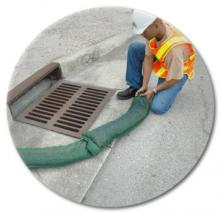Construction and Development
 Construction sites can be major contributors to stormwater pollution. Soil, cement wash, asphalt, oil and other hazardous debris from construction sites often make their way into the stormdrain system. Follow these tips for more waterway-friendly building.
Construction sites can be major contributors to stormwater pollution. Soil, cement wash, asphalt, oil and other hazardous debris from construction sites often make their way into the stormdrain system. Follow these tips for more waterway-friendly building.
- Store Materials Safely: Keep construction materials and debris away from the street, gutter and stormdrains. Cover exposed stockpiles of soil, sand or gravel and excavated material with plastic sheeting to protect from rain, wind and runoff. Store materials and debris in a designated waste area. Use watertight containers, pallets, covers and other containment structures to secure materials and wastes. Include material safety data sheets (MSDS) for materials used and stored on the project.
- Preventing Erosion: Avoid excavation or grading during wet weather. Plant temporary vegetation or add hydro mulch on slopes where construction is not immediately planned, and permanent vegetation once excavation and grading are complete. Construct diversion dikes to channel runoff to a detention basin and around the construction site. Use gravel approaches where truck traffic is frequent to reduce soil compaction and limit the tracking of sediment into the streets. Consider use of additional temporary erosion control BMPs for those areas that are not undergoing active construction. Incorporate street sweeping measures and control BMPs to reduce sediment tracking.
- Cleaning & Preventing Spills: Use a drip pan and funnel when draining or pouring fluids. Sweep up dry spills, instead of hosing. Be ready for spills by preparing and using spill containment and cleanup kits that include safety equipment and dry cleanup materials such as kitty litter or sawdust. Ensure workers are trained in spill prevention and clean-up. To report serious spills, call 911.
- Maintaining Vehicles & Equipment: Maintain and refuel vehicles and equipment at a single location on-site, away from the street, gutter and stormdrains. Perform major equipment repairs and washings off-site. Inspect vehicles and equipment frequently for leaks, and prevent leaks from stored vehicles by draining gas, hydraulic oil, transmission, and brake and radiator fluids. Use designated fueling and maintenance locations which are on impervious surfaces and bermed off to protect against stormwater run-on and run-off. Ensure equipment is leak-free.
- Ordering Materials & Recycling Waste: Reduce waste by ordering only the amounts of materials needed for the job. Use recycled or recyclable materials whenever possible. You can recycle broken asphalt, concrete, wood, and cleared vegetation. Dispose of hazardous materials through a hazardous waste hauler or other means in accordance with the construction permit. Non-recyclable materials should be taken to a landfill or disposed of as hazardous waste.
- Concrete and mortar application: Never dispose of cement washout into driveways, streets, gutters or drainage ditches. Wash concrete mixers and equipment only in specified washout areas, where the water flows into lined containment ponds. Cement wash water can be recycled by pumping it back into cement mixers for reuse.
Construction Site BMP (Best Management Practice) Implementation Resource Links
- California Stormwater Quality Association Construction Handbook (requires subscription)
https://www.casqa.org/resources/bmp-handbooks/construction
- Caltrans Construction Site Guidance Documents
http://www.dot.ca.gov/hq/construc/stormwater/manuals.htm
- Orange County Watersheds Website
Includes all CASQA BMP Fact Sheets and the SWPPP Template
http://ocwatersheds.com/documents/bmp/constructionactivities




